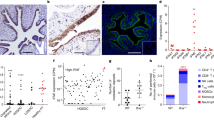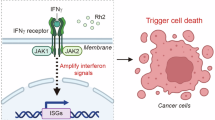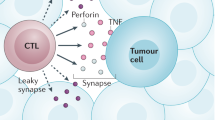Summary
Intereferon-γ (IFN-γ) has some anti-tumour activity in human ovarian cancer. This cytokine inhibited proliferation in three of four ovarian cancer cell lines in vitro. We then compared the action of IFN-γ in two cell lines, one sensitive and one resistant to its growth inhibitory effects. IFN-γ signalling appeared normal in both cell lines, with stat1 DNA binding activity detectable at 30 min. Continuous exposure to IFN-γ for 2–3 days was necessary for an irreversible effect on cell growth and apoptosis in cells sensitive to growth inhibition. During this time there was an increase in mRNA for the CKI p21, but no alterations in mRNA levels for other members of the CKI family. Maintenance of p21 mRNA required continuous mRNA synthesis. mRNA for the transcription factor IRF-1 was also induced in growth inhibited cells with similar kinetics to those observed for p21. Maximal induction of both p21 and IRF-1 mRNA was observed after 2–3 days IFN-γ exposure as the cells became committed to cell death. There was also a rapid increase in p21 and IRF-1 mRNA in cells resistant to the growth inhibitory effects of IFN-γ, but this increase was not maintained. Thus, continuous interaction with the IFN-γ receptor, together with a sustained induction of p21 and IRF-1, is associated with growth inhibitory and apoptotic effects of IFN-γ in ovarian cancer cells.
Similar content being viewed by others
Article PDF
Change history
16 November 2011
This paper was modified 12 months after initial publication to switch to Creative Commons licence terms, as noted at publication
References
Andrews, N. C. & Faller, D. V. (1991). A rapid micropreparation technique for extraction of DNA-binding proteins from limiting numbers of mammalian cells. Nucleic Acids Res 19: 2499
Bromberg, J. F., Horvath, C. M., Wen, Z. L., Schreiber, R. D. & Darnell, J. E. (1996). Transcriptionally active stat1 is required for the antiproliferative effects of both interferon-alpha and interferon-gamma. Proc Natl Acad Sci USA 93: 7673–7678.
Buard, A., Vivo, C., Monnet, I., Boutin, C., Pilatte, Y. & Jaurand, M. (1998). Human malignant mesothelioma cell growth: activation of Janus kinase 2 and signal transducer and activator of transcription 1α for inhibition by interferon-γ. Cancer Res 58: 840–847.
Burke, F., East, N., Upton, C., Patel, K. & Balkwill, F. R. (1997). Interferon gamma induces cell cycle arrest and apoptosis in a model of ovarian cancer: enhancement of effect by batimastat. Eur J Cancer 33: 1114–1121.
Chin, Y. E., Kitagawa, M., Su, W. C. S., You, Z. H., Iwamoto, Y. & Fu, X. Y. (1996). Cell-growth arrest and induction of cyclin-dependent kinase inhibitor p21 (waf1/cip1) mediated by stat1. Science 272: 719–722.
Church, G. M. & Gilbert, W. (1984). Genomic sequencing. Proc Natl Acad Sci USA 81: 1991–1995.
Elbendary, A., Berchuck, A., Davis, P., Havrilesky, L., Bast, R. C. Jr, Iglehart, J. D. & Marks, J. R. (1994). Transforming growth factor beta 1 can induce CIP1/WAF1 expression independent of the p53 pathway in ovarian cancer cells. Cell Growth Differ 5: 1301–1307.
Fan, Z., Lu, Y., Wu, X. P., Deblasio, A., Koff, A. & Mendelsohn, J. (1995). Prolonged induction of p21 (cip1/waf1)/cdk2/PCNA complex by epidermal growth-factor receptor activation mediates ligand-induced A431 cell-growth inhibition. J Cell Biol 131: 235–242.
Gavrieli, Y., Sherman, Y. & Ben Sasson, S. A. (1992). Identification of programmed cell death in situ via specific labeling of nuclear DNA fragmentation. J Cell Biol 119: 493–501.
Harvat, B. L., Seth, P. & Jetten, A. M. (1997). The role of p27 (kip1) in γ-interferon-mediated growth arrest of mammary epithelial cells and related defects in mammary-carcinoma cells. Oncogene 14: 2111–2122.
Hobeika, A. C., Subramaniam, P. S. & Johnson, H. M. (1997). IFN-α induces the expression of the cyclin-dependent kinase inhibitor p21 in human prostate-cancer cells. Oncogene 14: 1165–1170.
Jakus, J. & Yeudall, W. A. (1996). Growth-inhibitory concentrations of EGF induce p21 (waf1/cip1) and alter cell-cycle control in squamous carcinoma-cells. Oncogene 12: 2369–2376.
Jeoung, D. I., Tang, B. & Sonenberg, M. (1995). Effects of tumor necrosis factor-alpha on antimitogenicity and cell cycle-related proteins in MCF-7 cells. J Biol Chem 270: 18367–18373.
Langdon, S. P., Lawrie, S. S., FG, H., Hawkes, M. M., McDonald, M. M., Hayward, A., Ip, S., Hilgers, J., Leonard, R. C. F. & Smyth, J. F. (1988). Characterisation and properties of nine human ovarian adenocarcinoma cell lines. Cancer Res 48: 6166–6172.
Leaman, D. W., Leung, S., Li, X. & Stark, G. R. (1996). Regulation of STAT-dependent pathways by growth factors and cytokines. Faseb J 10: 1578–1588.
Nicholson, S. E. & Hilton, D. J. (1998). The SOCS proteins: a new family of negative regulators of signal transduction. J Leukoc Biol 63: 665–668.
Pujade-Lauraine, E., Guastalla, J-P, Colombo, N., Devillier, P., Franciois, E., Fumoleau, P., Monnier, A., Nooy, M., Mignot, L., Bugat, R., Marques, C., Mousseau, M., Netter, G., Maloisel, F., Larbaoui, S. & Brandely, M. (1996). Intraperitoneal recombinant interferon gamma in ovarian cancer patients with residual disease at second-look laparotomy. J Clin Oncol 14: 343–350.
Sakamoto, H., Yasukawa, H., Masuhara, M., Tanimura, S., Sasaki, A., Yuge, K., Ohtsubo, M., Ohtsuka, A., Fujita, T., Ohta, T., Furukara, Y., Iwase, S., Yamada, H. & Yoshimura, A. (1998). A Janus kinase inhibitor, JAB, is an interferon-gamma-inducible gene and confers resistance to interferons. Blood 92: 1668–1676.
Sangfelt, O., Erickson, S., Einhorn, S. & Grander, D. (1997). Induction of cip/kip and INK 4 cyclin-dependent kinase inhibitors by interferon-α in hematopoietic-cell lines. Oncogene 14: 415–423.
Tanaka, N., Ishihara, M., Lamphier, M. S., Nozawa, H., Matsuyama, T., Mak, T. W., Aizawa, S., Tokino, T., Oren, M. & Taniguchi, T. (1996). Cooperation of the tumour suppressors IRF-1 and p53 in response to DNA damage. Nature 382: 816–818.
Taniguchi, T., Lamphier, M. S. & Tanaka, N. (1997). IRF-1: the transcription factor linking the interferon response and oncogenesis. Biochim Biophys Acta 1333: M9–17.
Towbin, H., Staehelin, T. & Gordon, J. (1979). Electrophoretic transfer of proteins from polyacrylamide gels to nitrocellulose sheets: procedure and some applications. Proc Natl Acad Sci USA 76: 4350–4354.
Author information
Authors and Affiliations
Rights and permissions
From twelve months after its original publication, this work is licensed under the Creative Commons Attribution-NonCommercial-Share Alike 3.0 Unported License. To view a copy of this license, visit http://creativecommons.org/licenses/by-nc-sa/3.0/
About this article
Cite this article
Burke, F., Smith, P., Crompton, M. et al. Cytotoxic response of ovarian cancer cell lines to IFN-γ is associated with sustained induction of IRF-1 and p21 mRNA. Br J Cancer 80, 1236–1244 (1999). https://doi.org/10.1038/sj.bjc.6690491
Received:
Revised:
Accepted:
Published:
Issue date:
DOI: https://doi.org/10.1038/sj.bjc.6690491
Keywords
This article is cited by
-
Low doses of IFN-γ maintain self-renewal of leukemia stem cells in acute myeloid leukemia
Oncogene (2023)
-
Novel Human Anti-PD-L1 mAbs Inhibit Immune-Independent Tumor Cell Growth and PD-L1 Associated Intracellular Signalling
Scientific Reports (2019)
-
Activated CD4+T cells enhance radiation effect through the cooperation of interferon-γ and TNF-α
BMC Cancer (2010)
-
A novel approach in the treatment of neuroendocrine gastrointestinal tumors: Additive antiproliferative effects of interferon-γ and meta-iodobenzylguanidine
BMC Cancer (2004)
-
Malignant germ cell tumours of the testis express interferon-γ, but are resistant to endogenous interferon-γ
British Journal of Cancer (2003)



